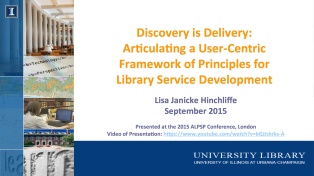This morning I came across the handout from a talk I gave at the 1999 ALA Midwinter Meeting at the ACRL Alliances for New Directions in Teaching and Learning Discussion Group. The title was “Virtual Futures: Developing New Models of Instruction” and my assertion was that libraries need to become “rich interactive learning environments” that “extend time and place.”
I couldn’t help but reflect on what changes we have seen in library websites since that 1999 talk, in which I strongly urged librarians to post copies of their print handouts online, given that this morning I also uploaded the slides from my presentation at the 2015 ALPSP Conference, Discovery is Delivery: Articulating a User-Centric Framework of Principles for Library Service Development, in which I discuss the robust discovery environment that is our library website at the University of Illinois at Urbana-Champaign.
Information literacy and instruction has been central to my career as a librarian from the time I discovered the specialty in library school. I have taught hundreds of course and thousands of students in ways that come immediately to mind – in a physical classroom, demonstrating, facilitating, giving feedback, etc. I find this work very rewarding and experience great joy in watching students take hold of their research topics and in working collaboratively with faculty on assignment and course design.
I also, however, practice my information literacy craft in another way that is less obvious but ultimately reaches even more students than I could ever reach directly in a classroom. For more than 20 years I have been serving on local, regional, and national teams that are responsible for the design and implementation of online research environments because I recognize that the library website is a classroom for our users. This is true for those who receive information literacy instruction directly and those who do not. My goal is to contribute to creating online research environments that support successful information seeking practices and serve the inquiry goals of our users.
I am also motivated by a desire to stop devoting our limited instruction time to training users to wrestle with systems that are at best cumbersome and are sometimes just plain broken. It demoralizes even the most dedicated instruction librarians I know to have to explain how to use library tools that are in desperate need of usability and user experience improvements. You may have watched Roger Schonfeld’s painful journey from citation to full-text PDF in Dismantling the Stumbling Blocks that Impede Researcher Access to E-Resources; imagine having the burden of teaching students that this is the way it is designed to work!
I’m pleased that, as Coordinator for Information Literacy Services and Instruction at the University of Illinois at Urbana-Champaign, I have been a welcomed and active partner in our discovery and delivery work since my very first months on the job in 2002 when I was appointed to “Access Task Force Working Group 1: Integrated Information Environment/Portals” that recommended the Library implement a federated search system and OpenURL resolver.It is a great strength of our library that we have always included public services, technical services, and technology services experts on our discovery system implementation teams, starting from when we implemented an automated library circulation system in the 1970s! I’ve been on groups that implemented Voyager, attempted implementation of WebFeat, implemented SFX, piloted and then decommissioned Primo, transitioned from OCLC FirstSearch to WorldCat Discovery, and created and continue to develop Easy Search.
With almost 15 years of work in this area at Illinois, I’ve been involved in many specific projects. I’m particularly proud of the work that Susan Avery and I did to assess Primo from an information literacy and student learning perspective (presented at LOEX 2014) and how our work has served as a basis for other librarians doing similar evaluations. I am also pleased with the results of a project that I coordinated to review a decade of user survey results [Graduate/Professional Survey (2004), Undergraduate Survey (2005); Faculty/Staff Survey (2006); LibQUAL+ (2008); Ithaka S+R Faculty Survey (2013); LibQUAL+ (2014)] to investigate trends in user perspectives on discovery and principles for user-centered design. We found that our users consistently value seamless digital delivery, coherent discovery pathways, tools that are as simple as possible but not simplistic, tools that provide not everything but “my everything,” transparency, and independence. I also did a analysis of the reports library teams have written about our discovery systems. Library staff prioritize transparency, predictability/explain-ability, customizability, and co-development opportunities in information discovery systems.

Our user and staff principles are very complementary and serve as a strong, guiding foundation for the work of the Search, Discovery, and Delivery working group, which is responsible for continuing to develop Easy Search. While we have integrated WorldCat Discovery as a target in Easy Search, we have determined that Easy Search better meets the needs of our users as the default search box on the website than any currently commercially available discovery layer that could replace it. As an evidence-based organization, we will continue our assessment and analysis (see our Discovery Research Portal for a much longer list of studies than I have mentioned already).
As an information literacy librarian, I look forward to many years to come serving on working groups, task forces, implementation teams, and committees that will continue to seek the creation of the best possible discovery and delivery environments for our users. We have made progress but have a long way to go. I remain committed though. The library website is a classroom for which I am an instructional designer.